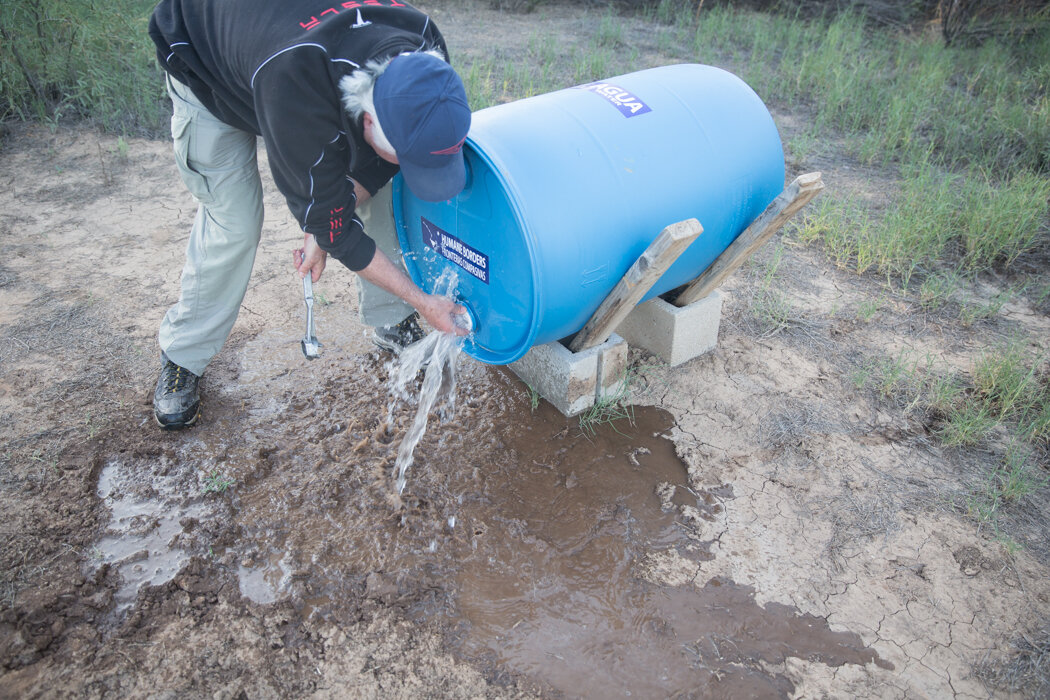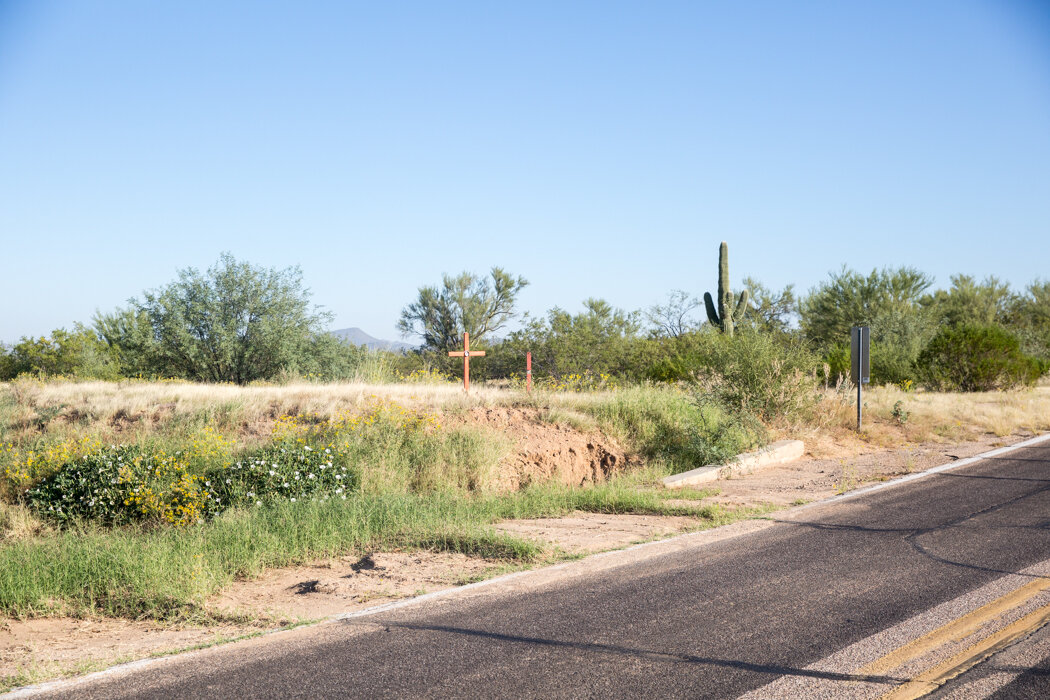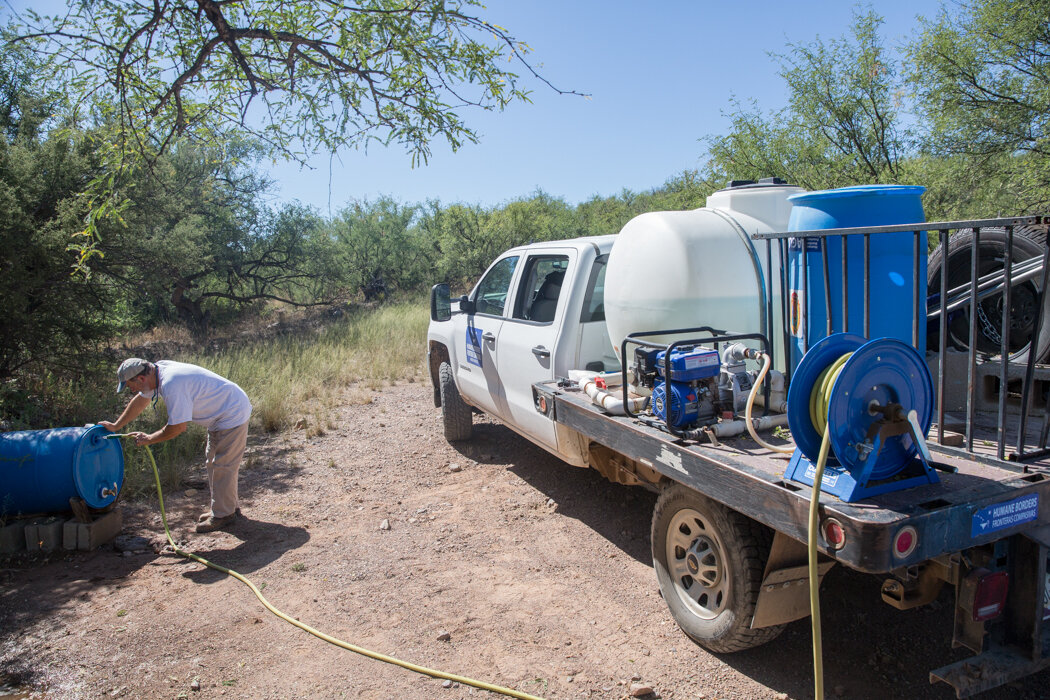This past Friday I went on a water run with Humane Borders to refill water tanks for migrants crossing through the desert. It was my first trip of many to come- not only with Humane Borders- and the reason I’m here. Some things I learned: the thing to fear most when going on these runs is vigilantes- they haven’t hurt any volunteers but make a sport of murdering, raping, generally victimizing migrants. So far there have been no consequences for them doing those things. The 70 miles between Tucson and the border is empty with narrow roads and very few people traveling those roads. There’s a check point about 30 miles before the border which is basically racial profiling, for whites they glance in the car and casually ask if you’re a citizen and let you pass. There were white G4 vans parked on the side of the road- I was told they are mercenaries working for a private company- waiting to grab a migrant and take them to ICE. I was told there are fewer migrants passing through this year and summer than last year.
It was my first experience and as usual, I’m finishing this post about a week after the trip and have since been on a couple of other trips with Tucson Samaritans. Different people report different facts. For instance, on other trips, I heard that the G4 vans aren’t allowed to take migrants directly to detention center, they have to take them to the border first and get them processed. I’m not sure which thing is true. The one thing everyone seems to be able to agree on is that ICE changes its operating procedures nearly every week.
I pulled up at 6AM and they were waiting on me to start the day. We had about 5 stops to make, all south of Tucson (though now I can’t really remember if that number is right- seems right…ish).
First stop was the gas station just outside of the city.
At the first water stop, we found a carpet shoe which is a cloth boot fastened on top of a regular shoe with carpet on the bottom and camouflage fabric on the top to prevent your foot prints from showing up in the dirt/sand.
Another view of the carpet shoe.
A view of the road near the water stop. This isn’t a migrant trail, but passes near one- I kept trying to imagine a view similar to this- sunny, hot, uneven terrain, empty except for hostile vegetation. In other areas, I’d wander off and the breeze with only the hum of insects made me pause to confirm those were insects and not voices, trees swaying and not people in the shadows.
Checking the water. The barrels are about 55 gallons, I think. At each barrel, we’d unlock the top lock and check to see if the water was visibly ok- nothing floating in it, no algae. Someone would always do a taste test, too. A frequent problem was a loose seal between the nozzle and the barrel which would result in a slow water leak.
The blue flag that’s to indicate that there’s a water barrel nearby. Not sure how far a way you can see these flags, from the roads we traveled in the truck, it seemed you had to practically be next to the barrel to see it.
The three guys that went on the trip that day. The volunteers are interesting, from all walks of life, most having a history of doing some kind of human rights work, speaking up, and generally trying to make the world and earth a good place for humans to co exist. They’re all pretty much white and retired or semi retired but they’re not all men.
This sticker of the virgin Mary is on the water barrels. I believe she is the patron saint of the migrant’s journey. It lets them know this water comes from friends and is to help.
A volunteer. He has a Tesla. As we can see by his jacket. And he started his Tesla’s AC from his phone 15 minutes before we returned to the parking lot at the end of the day. He also is a semi/mostly retired trial attorney from Vermont who moved here some years ago and continues to help appeal asylum cases for migrants that have been denied. This man has done and continues to do important work- based on what he recounted- but it was really overshadowed by that Tesla.
After discovering that the barrel was leaking, they decided to unscrew it, let the water out and try to re seal it.
Nice looking berries, probably poisonous.
Hot.
Around these water barrels, every little thing that doesn’t come from nature gets a second and third look- mostly from me. Everything seems to hold significance and be a sign of migrants passing through. This tiny yellow ball that looks like chocolate candy made me wonder if someone had been by recently. Or was it only from a county employee who’d been on the land to check the area. Was it even candy? It looks like it, but maybe it’s, like, a bullet or something.
Some unfriendly vegetation, this is cholla. I know to avoid the large spines, but I always want to touch and press on the spongey part where there aren’t any visible spines. This is a mistake because in those areas there are tiny soft spines that lodge in your fingers and are painful, annoying, and difficult to remove.
Frank found a water bottle, perhaps belonging to a migrant.
On the way and along the road, we stopped at some crosses put up by Alvaro. He has a special weekly crosses trip to put up these wooden crosses that he makes in the red dot spots which indicate areas where migrants have died. I went on this trip a few days after this water trip and it was a bit of a fiasco because of the media that also attended, but the general idea to not let these deaths be invisible, to remind us/the government that thousands of people are dying on our soil due to inability to get the immigration thing together, that we are all somehow complicit in these deaths- is important.
Some crosses are destroyed by vigilantes and general assholes. some crosses are more decorated as time passes. Alvaro puts a couple of pieces on the cross from items he finds in the desert left by migrants, always a dot in the center for the red dots on the map, and then a couple of other metallic pieces he nails on. The rosaries, ribbons, and flowers are added by others.
It’s difficult to see, but through the blurry barbed wire, there’s a colorful blanket covered in sand that probably belonged to a migrant.
Another cross by Alvaro with a red dot and the pieces nailed on to each end of the cross. The rosary made of painted chickpeas was added by someone else.
Chickpea rosary.
You can see the crosses next to the road. There is no good place to die in this migration, but when it is so close to the road it seems extra strange and sad because you wonder if people saw this person and just drove by. Or were they murdered, or were they so dehydrated that they were delirious and wandered into the road at night and were accidentally struck by a passing vehicle.
On our way to another stop.
Trying some water and dumping it out.
A meeting of the minds.
A long hot road. But not a migrant path.
Trying to straighten a drooping water flag.
Water truck in the wild. The white tank closest to the cab is the supply of water. We had extra blue barrels to replace faulty barrels from various locations, extra flags and flagpoles, and extra of everything that we might need to fix a barrel. Sometimes a barrel leaks innocently, sometimes it has been tampered with on purpose.
Just a view. That sharp pointy peak in the middle is Baboquivari and it is where the Tohono O'odhama tribe believe their creator resides, and where all of creation started.
Just a view of heads and a flag.
A view of Baboquivari in the distance.
A flag in the desert.
Refilling the water barrel.
Chitting and chatting.
Water barrel.
A view of the US- with Baboquivari in the distance- from the Mexico side. The razor wire is abundant right here and really just a PR move by Trump because no one would be silly enough to cross right next to the border guards.




































